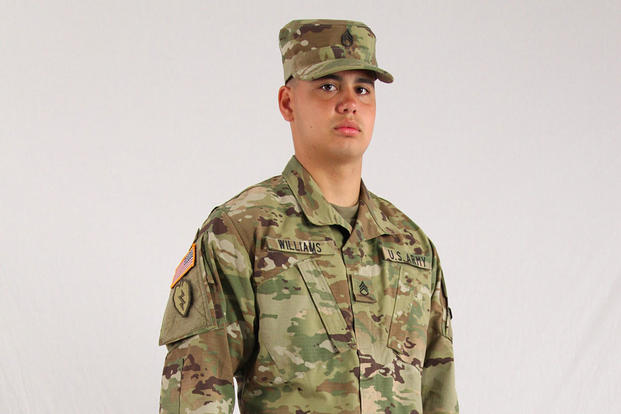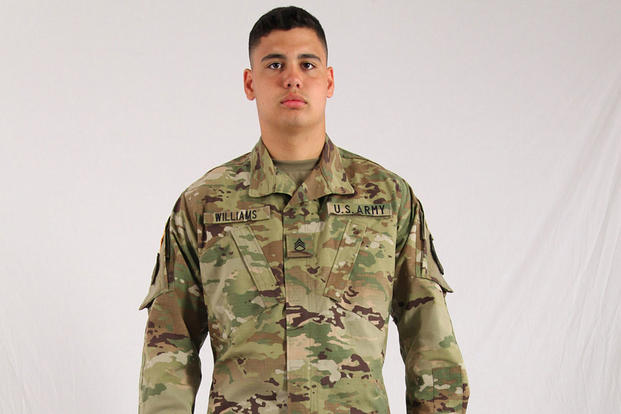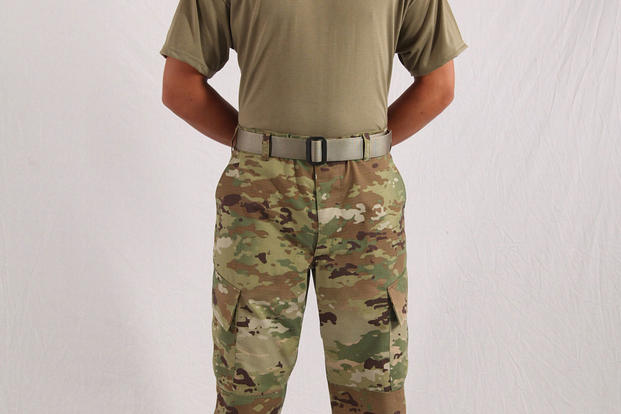The U.S. Army has laid out a plan to outfit soldiers with the service's new camouflage pattern that uniform officials maintain will perform as well as the MultiCam pattern troops wear in Afghanistan.
Col. Bob Mortlock, the head of the Army's Project Manager Soldier Protection and Individual Equipment, sat down with reporters to discuss the long-awaited roll-out of the new Operational Camouflage Pattern, or OCP.
Mortlock described the adoption of the new pattern as an important step for the Army.
"It's important to the Army, and the reason it is important to the Army is because it is all about force protection," he said. "In the close fight, soldiers rely on camouflage to provide concealment, and that is critically important to their mission effectiveness."
Army units are scheduled to receive an All Army Activities, or ALARACT, message today that lays out the service's plans to transition from the current Army Combat Uniform in the digital Universal Camouflage Pattern to the updated ACU in the new Operational Camouflage Pattern.
Soldiers can begin wearing the new OCP uniforms once they go on sale at Military Clothing Sales stores July 1. The new ACUs will also feature several new improvements such as a redesigned collar and shoulder pockets. The goal will be to have every soldier outfitted with OCP camouflage uniforms by Oct. 1, 2019.
Army senior leaders selected OCP after the service completed its exhaustive Phase IV camouflage effort in 2013, an effort that Mortlock described as "the most rigorous combat uniform camouflage testing in history."
The service launched the effort in 2009 to find a replacement for the current Universal Camouflage Pattern, a pixilated pattern known for its poor performance in Afghanistan. It involved multiple years of testing of multiple patterns in a variety of operational environments.
The effort resulted in the selection of a base pattern that is designed to work well across multiple operating environments.
The effort also studied the possibility of having a family of camouflage patterns, which consisted of bookend patterns around this base pattern, Mortlock said.
"We have done extensive testing on what is the benefit of having the arid [desert] pattern and the dark woodland pattern to compliment the base Operational Camouflage Pattern," Mortlock said. "The Army hasn't made a final decision there yet, and there is no timetable to make that decision."
OCP vs. MultiCam
One of the top contenders in the Phase IV testing was MultiCam, a unique blend of greens, browns and tans has been a favorite of Special Operations Command for a decade. The Army selected MultiCam, made by Crye Precision, in 2010 as the clear winner over several other patterns to issue to soldiers deploying to Afghanistan. The Army renamed it the Operational Enduring Freedom Camouflage Pattern.
The new Operational Camouflage Pattern is similar to MultiCam because Crye developed the pattern with the Army for its Objective Force Warrior program in 2002. The company later made small improvements to the pattern for trademark purposes and called it MultiCam.
"The two patterns -- the Operation Enduring Freedom Camouflage Pattern that currently deployed soldiers have and the Operational Camouflage Pattern coming out right now -- the key point is they perform very similarly from a camouflage and concealment perspective," Mortlock said.
When pressed to describe the visual differences between the two patterns, Mortlock would say only that OCP "has been optimized for performance across all the military operating environments that the Army may face. It has also been optimized for night-time operations."
As far as the "visual, daytime characteristics, I'm not going to get into at this time," he said.
Mortlock did provide some background on the development of OCP, which was formerly known as Scorpion W2.
"It was submitted as part of the Phase IV study," Mortlock said, adding that "it was submitted in the 2011-2012 timeframe."
OCP, the government's pattern, went through "parts of" the phase IV testing, Mortlock said.
"At the time, the government down-selected in stage two testing of Phase IV; we only had the vendor selections and vendor families through that stage two testing," Mortlock said.
However, Mortlock said that the new OCP was tested against the Operation Enduing Freedom Camouflage Pattern, or MultiCam, in tests that included photo simulation --which involves the use of calibrated photos of the patterns to make a computerized test.
The test involved identifying individuals wearing the different patterns at multiple ranges and settings.
Once testing was concluded, Mortlock said there was "no difference" in performance between the new OCP and the OEF-CP, or MultiCam.
Outfitting the Ranks with Improved OCP ACUs
The Army will begin to make OCP uniforms available to soldiers beginning July 1 in specific Military Clothing sales stores.
One of the challenges of the plan will be dealing with the production capacity of the industrial base, Mortlock said. To deal with it, the Army will supply OCP uniforms in three waves, he said.
"The Army staff has coordinated which installations will get the uniforms at what time, and that will be detailed in the ALARACT that comes out," Mortlock said.
The first wave of stores will receive OCP July 1. The second wave of stores will get them Sept. 2, he said.
"When we do a wave fielding, you understand we also have to resupply the first wave because they start selling it," Mortlock said, adding that the third wave will come to stores Nov. 1.
Army officials said they did yet know how much the new OCP ACUs will cost, but they said it will be similar to the cost of a complete ACU in the current Universal Camouflage Pattern -- $102.04, according to Lt. Col. Jesse Stalder, an Army spokesman.
Enlisted soldiers, sergeants and officers will have to buy their uniforms. Junior enlisted and sergeants receive an annual clothing allowance. Officers receive a one-time clothing allowance when commissioned.
New soldiers will be issued OCP ACUs in initial entry training beginning in January 2016, Army officials maintain.
Between July 1 and September 2019, soldiers can wear OCP uniforms, UCP uniforms and the flame-resistant uniforms in the Operation Enduring Freedom Camouflage Pattern.
In addition to a new pattern, the new OCP ACUs will feature several upgraded features based on soldier feedback, Mortlock said. Some of the improvements include a zipper closure to replace the hook and loop flap closure on the shoulder pockets. The collar will be more of a fold-down design and no longer have the hook and loop collar extension. Internal elbow pad and knee pad pockets have been removed, but the reinforcement will stay.
The OCP ACUs will also feature a new Tan 499 T-shirt and belt, as well as coyote brown boots. But during the transition, soldiers can wear the current sand color T-shirt, belt and boots, Mortlock said.
The Army plans to produce all equipment items such as body armor, packs and pouches in OCP, but until that happens, soldiers will use existing stocks of UCP-patterned equipment in training scenarios. They will also be authorized to use equipment printed in OEF-CP.
"There is going to be a lot of mix-match uniforms out there," Mortlock said.
Soldiers who deploy on real-world missions, however, will receive uniforms and equipment printed in OCP, Mortlock said.
"We are going to transition over time. That's to relieve the burden to our soldiers initially, but it also allows us to make maximum use of our residual stocks," Mortlock said.
-- Matthew Cox can be reached at Matthew.Cox@military.com.
































